Harald Scherm, Editor-in-Chief
Krishna V. Subbarao, Editor-in-Chief
2015-2017
December 2017
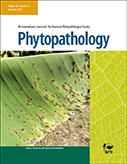 Computer Vision for High-Throughput Quantitative Phenotyping: A Case Study of Grapevine Downy Mildew Sporulation and Leaf Trichomes
Computer Vision for High-Throughput Quantitative Phenotyping: A Case Study of Grapevine Downy Mildew Sporulation and Leaf Trichomes
View Article
Divilov et al. compared estimates of grapevine downy mildew sporulation and leaf trichomes obtained from manual visual and computer vision rating methods and determined that the computer method was both accurate and significantly faster (at least 90% less time for an experienced rater scoring sporulation). This cost- and time-efficient rating method will likely find applications in high-throughput phenotyping in breeding and genetic analyses of this and other pathosystems.
REVIEW: Signaling Mechanisms Underlying Resistance Responses: What Have We Learned, and How Is It Being Applied?
View Article
In this month’s Review article, Kachroo et al. discuss advances in our understanding of plant defense signaling and how this knowledge has been or may be utilized to develop resistance against pathogens. Resistance (R) gene-mediated immunity, PAMP-triggered immunity, “susceptibility”-type genes, effector targeting, and systemic acquired resistance are all reviewed in the context of applicability to generate plant immunity. The authors conclude that commercial applications have been limited to transgene-induced silencing, R genes, and susceptibility genes and that this is due in part to the pathogen’s ability to break resistance. Conserved signaling components less prone to change under evolutionary pressure may be valuable targets to enhance resistance.
November 2017
 A Risk Assessment Model for Bacterial Leaf Spot (BLS) of Pepper, Caused by Xanthomonas euvesicatoria
A Risk Assessment Model for Bacterial Leaf Spot (BLS) of Pepper, Caused by Xanthomonas euvesicatoria
View Article
In an elegant study, Dutta et al. developed risk assessment models for BLS of pepper based on the soil nutrient status at planting. Concentrations of copper, manganese, potassium, and the iron/zinc ratio accurately predicted BLS severity. The authors validated the models at three independent locations and demonstrated that lower disease risk correlated with higher relative expression of NPR1 and PR1 genes in pepper.
Disease-Suppressive Soils: New Insights from the Soil Microbiome
View Article
Schlatter et al. compare and contrast three model suppressive soil systems and conclude that they provide from specific to general suppression along a continuum. Take-all decline of wheat is an example of specific suppression, whereas the natural suppression of Rhizoctonia solani based on antagonists and the suppression of potato scab associated with antagonistic Streptomyces spp. are examples of general suppression. The authors discuss the implications of identifying interactions in soils to further elucidate the function of the phytobiome in harnessing the potential of indigenous soil microbes for disease management.
October 2017
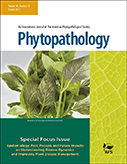 Phytopathology Focus Issue: Epidemiology
Phytopathology Focus Issue: Epidemiology
View Focus Issue
The current Focus Issue features 17 research articles that span from historical to contemporary topics in epidemiology. The papers address broad themes in epidemiology, including social and political consequences of disease epidemics, decision theory and support, pathogen dispersal and disease spread, inoculum thresholds, disease assessment and pathogen biology, disease resistance, and integration of these disciplines for disease management.
September 2017
 Growth of Verticillium longisporum in Xylem Sap of Brassica napus Is Independent from Cultivar Resistance but Promoted by Plant Aging
Growth of Verticillium longisporum in Xylem Sap of Brassica napus Is Independent from Cultivar Resistance but Promoted by Plant Aging
View Article
Lopisso et al. determined that resistance against Verticillium longisporum in oilseed rape cultivars is not related to the nutritional status or the presence of soluble antifungal metabolites in the xylem sap following infection. Rather, cultivar resistance is related to the inherent structural defenses in resistant cultivars.
Chinese translation by Chang-Lin Xiao, USDA-ARS, Parlier, CA
Lopisso 等研究了油菜品种对Verticillium longisporum 的抗性是否与品种的营养状态或侵染后植物维管束汁液里的可溶性抗真菌代谢物有关。他们的研究表明品种抗性与两者都不相关,但是与抗病品种的内在的结构防预有关。
Spanish translation by Dr. German Sandoya, University of Florida
Lopisso y colaboradores investigaron si la resistencia a Verticillium longisporum en variedades de colza se relaciona con el estado nutricional o la presencia de metabolitos fungicidas solubles en el savia del xilema después de la infección. Sus resultados establecen que la resistencia en variedades no se debe a ninguno de estos factores, más bien a las inherentes defensas estructurales en variedades resistentes.
August 2017
 Harnessing Effector-Triggered Immunity for Durable Disease Resistance
Harnessing Effector-Triggered Immunity for Durable Disease Resistance
View Article
Zhang and Coaker discuss how to utilize recent scientific advances in a multilayered strategy for developing more durable plant disease resistance. The strategy involves integrating multiple R (resistance) gene structural domains, such as the nucleotide-binding leucine-rich repeat (NLR) domain, and their cognate effectors for effector-triggered immunity (ETI). As the authors point out, the recent advances in both DNA sequencing technologies and genome editing tools have enabled identification of pathogen effectors and NLRs at a faster pace, quickly adding to our bank of knowledge for successful deployment of the multilayered ETI approach.
July 2017
 Serotonin Regulates the Feeding and Reproductive Behaviors of Pratylenchus penetrans
Serotonin Regulates the Feeding and Reproductive Behaviors of Pratylenchus penetrans
View Article
The neurotransmitter serotonin as a regulator of feeding and reproductive behaviors is well established for sedentary cyst and root-knot nematodes but not for migratory lesion nematodes. Han et al. demonstrate that exogenous serotonin has similar effects on the lesion nematode, Pratylenchus penetrans. Using a combination of immunohistochemistry and serotonin reuptake inhibitors, Han et al. confirmed the presence of endogenous serotonin with similar functions. The authors conclude that identifying specific serotonin receptors offers new targets to disrupt nematode feeding and mating behaviors.
Chinese translation by Shouhua Wang, Ph.D., State Plant Pathologist | Plant Industry Division | Nevada Department of Agriculture | 405 South 21st Street, Sparks, NV 89431
神经传导物质血清素作为一种取食和繁殖行为的调节剂已经在固着性的胞囊线虫和根结线虫里得到广泛证实,但不清楚是否存在于迁移性的根腐线虫里。韩等人证实外源血清素对北方根腐线虫(Pratylenchus penetrans)产生类似于(内生血清素)的作用。 用免疫组织化学和血清素再吸收抑制剂两种方法, 韩等人也证实了内生血清素(在根腐线虫里)的存在以及其相似的功能。 作者们由此推断鉴定出特定的血清素受体可以作为用来破坏线虫取食和交配行为的新靶子。
Spanish translation by Dr. German Sandoya, University of Florida
El neurotransmisor serotonina como regulador de la alimentación y el comportamiento reproductivo está establecido en los nematodos de quiste sedentario y en el de la agalla de la raíz pero no en nematodos de lesiones migratorias. Han y colaboradores demuestran que la serotonina exógena tiene efectos similares en la lesión del nematodo, Pratylenchus penetrans. Con el uso de combinaciones de inmuno histoquímica y absorción de los inhibidores de la serotonina, los autores concluyen que la identificación de receptores específicos de serotonina ofrece nuevos objetivos para interrumpir los hábitos alimenticios y de apareamiento en nematodos.
June 2017
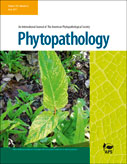 Sexual Reproduction in the Citrus Black Spot Pathogen, Phyllosticta citricarpa
Sexual Reproduction in the Citrus Black Spot Pathogen, Phyllosticta citricarpa
View Article
Tran et al. demonstrate mating in culture and genetic recombination in ascospore progeny of Phyllosticta citricarpa, the pathogen that causes black spot of citrus. While confirming the heterothallic nature of P. citricarpa, the authors conclude that sexual reproduction between isolates with complimentary MAT idiomorphs occurs through mycelial contact, or when spermatia fertilize receptive organs. This information provides new insights into the epidemiology of black spot and potentially new targets for fungicide development.
May 2017
Emergence of Resistance to Fungicides: The Role of Fungicide Dose
View Article
 Using a simple population dynamic model, Mikaberidze et al. studied the impact of fungicide dosage on the evolution and establishment of fungicide resistance in plant pathogens and validated the findings with empirical data on Zymoseptoria tritici, the causal agent of Septoria leaf blotch of wheat. The authors conclude that using either the lowest rate that provides effective disease control or the highest or lowest labeled rate delays the development of fungicide resistance, and they recommend not using intermediate rates.
Using a simple population dynamic model, Mikaberidze et al. studied the impact of fungicide dosage on the evolution and establishment of fungicide resistance in plant pathogens and validated the findings with empirical data on Zymoseptoria tritici, the causal agent of Septoria leaf blotch of wheat. The authors conclude that using either the lowest rate that provides effective disease control or the highest or lowest labeled rate delays the development of fungicide resistance, and they recommend not using intermediate rates.
Chinese translation by Dr. BoMing Wu, China Agricultural University, Beijing, China
Mikaberidze等人利用一个简单的群体动态模型研究了杀菌剂剂量对植物病原菌抗药性进化和抗药性种群建立的影响,并用引起小麦壳针孢叶枯病的病原菌 (Zymoseptoria tritici)的试验数据对模型进行了验证。他们得出结论,施用有效控制病害所需的最低用药量以及注册商标推荐的最高或者最低用药量均能延缓病原菌群体中抗药性的发展,并建议避免使用折中的用药量。
Spanish translation by Dr. German Sandoya, University of Florida
Mikaberidze et al. estudiaron el impacto de las dosis de fungicidas en la evolución en un modelo simple de dinámica de población y el establecimiento de la resistencia en patógenos de plantas y validaron estos descubrimientos con datos empíricos en Zymoseptoria tritici, el agente causal de la mancha por Septoria en trigo. Los autores concluyen que el uso de las dosis más bajas que proveen control de la enfermedad o las dosis extremas recomendadas (bajas o altas) retrasan el desarrollo de la resistencia al fungicida y recomiendan evitar las dosis intermedias.
April 2017
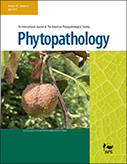 Spatial Genetic Structure of Coffee-Associated Xylella fastidiosa Populations Indicates That Cross Infection Does Not Occur with Sympatric Citrus Orchards
Spatial Genetic Structure of Coffee-Associated Xylella fastidiosa Populations Indicates That Cross Infection Does Not Occur with Sympatric Citrus Orchards
View Article
In an elegant comparison of more than 500 isolates of Xylella fastidiosa from citrus and coffee, Francisco et al. demonstrate that the populations from the two hosts are distinct, with little admixture between them, even though they were collected from geographically overlapping areas in Brazil. Isolates from coffee exhibited greater genetic diversity and allelic richness relative to isolates from citrus, and isolates were not cross-pathogenic across the two hosts.
March 2017
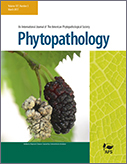 Phenazine-1-Carboxylic Acid Production by Pseudomonas fluorescens LBUM636 Alters Phytophthora infestans Growth and Late Blight Development
Phenazine-1-Carboxylic Acid Production by Pseudomonas fluorescens LBUM636 Alters Phytophthora infestans Growth and Late Blight Development
View Article
Morrison et al. demonstrated that a strain of Pseudomonas fluorescens from the rhizosphere of a strawberry plant reduced propagule numbers of Phytophthora infestans in the potato rhizosphere and the incidence of late blight on potato. Pathogen and disease suppression were a direct consequence of phenazine-1-carboxylic acid (PCA) production by the bacterium. PCA-deficient P. fluorescens mutants did not suppress disease nor was suppression related to the activation of defense-related genes in plants.
Chinese translation by Dr. BoMing Wu, China Agricultural University, Beijing, China
莫里森等人研究表明从草莓根围分离得到的一株荧光假单胞菌(Pseudomonas fluorescens)可减轻马铃薯晚疫病的发病率和降低晚疫病菌在马铃薯根际的繁殖数量。对病原菌和病情的抑制是由该细菌产生的吩嗪-1-羧酸(PCA)直接导致的。PCA缺陷突变P. fluorescens菌株不能抑制晚疫病,而且抑制与植物防御相关基因的激活无关.
Spanish translation by Dr. German Sandoya, University of Florida
Morrison et al. demuestran que una raza de Pseudomonas fluorescens de la rizosfera de la planta de fresa redujo el número de los propágulos de Phytopthora infestans en la rizosfera de la patata y en la incidencia del tizón tardío de la patata. La supresión del patógeno y de la enfermedad fueron consecuencias de la producción del ácido phenazine-1-carboxylic acid (PCA, por sus siglas en ingles). Los mutantes de P. fluorescens deficientes del PCA no contrarrestaron la enfermedad relacionada con la activación de los genes relacionados con defensas en plantas.
February 2017
 Development and Validation of an Infection Risk Model for Bacterial Canker of Kiwifruit, Using a Multiplication and Dispersal Concept for Forecasting Bacterial Diseases
Development and Validation of an Infection Risk Model for Bacterial Canker of Kiwifruit, Using a Multiplication and Dispersal Concept for Forecasting Bacterial Diseases
View Article
Many forecasting systems have been successfully developed and deployed for fungal and oomycete plant pathogens, but few are available for bacterial diseases. Beresford et al. developed an infection risk model for bacterial canker of kiwifruit that combines bacterial multiplication as a function of temperature and pathogen dispersal and infection as a function of rainfall into a daily risk index. They validated the model in a kiwifruit orchard in which the risk index predicted outbreaks of bacterial canker with 93% accuracy and suggest that this concept can be expanded to other bacterial diseases.
January 2017
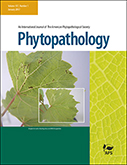 A Proposal for a Genome Similarity-Based Taxonomy for Plant-Pathogenic Bacteria That Is Sufficiently Precise to Reflect Phylogeny, Host Range, and Outbreak Affiliation Applied to Pseudomonas syringae sensu lato as a Proof of Concept
A Proposal for a Genome Similarity-Based Taxonomy for Plant-Pathogenic Bacteria That Is Sufficiently Precise to Reflect Phylogeny, Host Range, and Outbreak Affiliation Applied to Pseudomonas syringae sensu lato as a Proof of Concept
View Article
Biological species are groups of individuals that interbreed to produce fertile offspring; this “species” concept cannot be applied to bacteria, however, because they reproduce asexually. Bacterial plant pathogens are further complicated because most of the diversity exists among similar strains of the same species. Use of the “pathovar” concept alleviated this problem but had other limitations. Vinatzer et al. propose using genome similarity-based codes, which they call “life identification numbers” (LINs), to describe and name bacterial taxa. They demonstrate the utility of this approach using 93 genomes of Pseudomonas syringae. The authors found that LINs aligned well with genome-based phylogeny, were predictive of pathogenicity, and correlated with disease outbreaks caused by strains of the kiwifruit pathogen, P. syringae pv. actinidiae.
December 2016
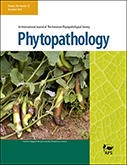 Mating-Type Gene Structure and Spatial Distribution of Didymella tanaceti in Pyrethrum Fields
Mating-Type Gene Structure and Spatial Distribution of Didymella tanaceti in Pyrethrum Fields
View Article
Pearce et al. investigated the possibility of sexuality in the tan spot pathogen (Didymella tanaceti), a presumed asexual species, by examining mating type (MAT) idiomorph frequencies in pyrethrum field collections. The authors evaluated 325 isolates from four fields using a MAT-specific multiplex PCR assay. Results revealed heterothallism and a significantly balanced ratio of mating types, which were distributed randomly throughout the sampling transects. The authors posit that a cryptic sexual cycle may occur within field populations of the pathogen, although the sexual morph could not be induced in laboratory crosses.
Chinese translation by Dr. BoMing Wu, China Agricultural University, Beijing, China
皮尔斯(Pearce)等人通过检测田间采集的匹菊褐斑病菌(Didymella tanaceti)独特交配型的频率,研究了其有性繁殖的可能性。作者利用交配型专化性的多重PCR检测分析了来自澳大利亚4块地的325个褐斑病菌分离物。结果显示该菌存在异宗配合,两种交配型(MAT1-1和MAT1-2)的比例接近1:1,均衡且随机分布于各样本分组中。尽管实验室的杂交努力未能获得其有性结构,作者推想匹菊褐斑病菌可能存在不为人知的有性阶段。
Spanish translation by Dr. German Sandoya, University of Florida
Pearce et al. investigaron la posible sexualidad en Didymella tanaceti, una especie presuntamente asexual, examinando las frecuencias del idiomorfo del tipo de apareamiento (MAT) en colecciones de campo de crisantemos. Los autores evaluaron 325 aislados del patógeno de 4 sitios utilizando cebadores para PCR multiplex específicos para MAT. Los resultados revelan heterotalismo y una proporción significativamente balanceada de tipos de apareamiento, las cuales se distribuyeron aleatoriamente a través del muestreo transversal. Los autores plantean que un ciclo críptico sexual podría ocurrir en el patógeno del manchado bronceado, aunque una forma sexual no podría inducirse en cruzamientos de laboratorio.
November 2016
 Genetic Analyses Suggest Separate Introductions of Pine Pathogen Lecanosticta acicola into Europe
Genetic Analyses Suggest Separate Introductions of Pine Pathogen Lecanosticta acicola into Europe
View Article
Janoušek et al. analyzed the fungus Lecanosticta acicola, which causes brown spot needle blight on Pinus spp., from three continents and 17 hosts using three genetic markers. The isolates from Mexico and Guatemala were found to be distinct and highly diverse; they could represent a cryptic species. The isolates from East Asia form a uniform and discrete group, and the isolates from North America and Europe belong to two distinct populations. Additional analyses strongly suggest independent introductions of two pathogen populations from North America into Europe. In addition, spread within Europe has likely occurred through conidial dispersion and ascospore dissemination, whereas intercontinental spread has likely occurred via the movement of infected plant material.
October 2016
Focus Issue: Disease Management in the Genomics Era
View Focus Issue
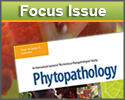
Major technological developments in high throughput DNA sequencing have been transformative to the biological sciences over the past decade and a half. In recent years, as costs of sequencing have decreased, the quality and quantity of data output have increased dramatically. The science of genomics stimulated by this technology has revolutionized biology in ways barely imagined even just a few years ago. In Plant Pathology, advances in genomics have offered unprecedented insights into the mechanisms of pathogenesis, genetic basis of disease resistance, genetics of host – pathogen interactions, population biology and other related fields. These provide opportunities for developing durable disease resistance to multiple pathogens and pests that remain effective over long periods of cultivation. These advances have also led to the development of novel markers for rapid pathogen detection and diagnosis and have thus contributed to disease management. The articles in this focus issue cover the application of this state-of-the-art technology to the study of nematode, viral, bacterial, fungal, and oomycete pathogens and their management.
September 2016
Identification and Differentiation of Monilinia Species Using High-Resolution Melting (HRM) Analysis
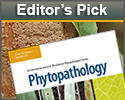 View Article
View Article
Papavasileiou
and colleagues describe a novel assay that uses HRM curve analysis to simultaneously differentiate six species of Monilinia that cause brown rot in stone fruits. M. fructicola is a quarantine pathogen but has recently been detected in several European countries. Use of this assay may prevent the rapid spread of this pathogen to other European countries.
Chinese translation by Dr. BoMing Wu, China Agricultural University, Beijing, China
Papavasileiou 及其合作者描述了一种新的检测方法,即利用高分辨率熔解曲线分析方法同时区分引起核果褐腐病的链核盘菌属(Monilinia)的6个种。桃褐腐病菌(Monilinia fructicola)目前仍是一种检疫病原菌,但是已经出现在一些欧洲国家。该检测方法的应用将有助于阻止桃褐腐病菌快速向其它欧洲国家传播。
Spanish translation by Dr. German Sandoya, University of California, Davis
Papavaileiou y colaboradores describen un nuevo ensayo que emplea un análisis de curva de fusión de alta resolución que simultáneamente es capaz de diferenciar seis especies de Monilinia, patógeno que causa el pudrimiento marrón en frutos con hueso. Monilinia fructicola, una especie hasta la fecha considerada un patógeno en cuarentena, recientemente apareció en varios países europeos. Con la disponibilidad de este ensayo se espera prevenir la expansión rápida a otros países europeos.
August 2016
Differentiation Among Blumeria graminis f. sp. tritici Isolates from Wheat in Israel
View Article
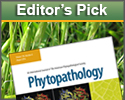 Ben-David et al. evaluated Blumeria graminis f. sp. tritici isolates from wheat and its wild relatives, including emmer wheat, using virulence assays and neutral molecular markers. Although their results showed little support for a distinct forma specialis of B. graminis on emmer wheat, they noted that isolates clearly differentiated into two distinct groups from cultivated and wild emmer wheat. Genetic overlap between the two groups was attributed to one-way gene flow of pathogen populations from domesticated wheat to wild emmer wheat.
Ben-David et al. evaluated Blumeria graminis f. sp. tritici isolates from wheat and its wild relatives, including emmer wheat, using virulence assays and neutral molecular markers. Although their results showed little support for a distinct forma specialis of B. graminis on emmer wheat, they noted that isolates clearly differentiated into two distinct groups from cultivated and wild emmer wheat. Genetic overlap between the two groups was attributed to one-way gene flow of pathogen populations from domesticated wheat to wild emmer wheat.
July 2016
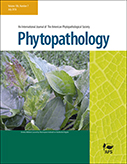 Kenyan Isolates of Puccinia graminis f. sp. tritici: Virulence and Breeding Implications
Kenyan Isolates of Puccinia graminis f. sp. tritici: Virulence and Breeding Implications
View Article
Resistance breeding has prevented losses caused by the wheat stem rust pathogen, Puccinia graminis f. sp. tritici, but the recent emergence of new combinations of virulence poses a new threat to wheat production. Newcombe et al. analyzed 140 isolates collected in Kenya over 6 years and discovered six novel races, of which three were in the virulent Ug99 group. The researchers further developed three wheat lines with combined resistance genes to enable pathogen monitoring and race identification.
Chinese translation by Dr. BoMing Wu, China Agricultural University, Beijing, China
抗病育种过去成功避免了小麦秆锈病菌引起的损失,但是近来新毒性组合的出现,又再次威胁到小麦的生产。Newcombe等人分析了6年来采自于肯尼亚的140株小麦秆锈病菌菌株,从中发现了6个新毒性小种,其中3个小种属于Ug99毒性种群。他们进一步培育出3个小麦品系,在其中聚合了不同抗性基因,使得鉴定和监测病菌的(这些新)小种成为可能。
Spanish translation by Dr. German Sandoya, University of California, Davis
La mejora de la resistencia ha prevenido las perdidas por el patógeno de la roya del trigo, Puccinia graminis f. sp. tritici, pero la reciente aparición de nuevas combinaciones de virulencia posee una amenaza recurrente a la producción de este cereal. Newcombe et. al. analizaron 140 aislados del patógeno recolectados en Kenia durante seis años descubriendo seis nuevas razas, de las cuales tres estuvieron en el mismo grupo de virulencia que Ug99. Los autores desarrollaron tres líneas de trigo que combinan genes de resistencia que permite el monitoreo del patógeno e identificación de razas.
June 2016
Rhizosphere Competence of Wild-Type and Genetically Engineered Pseudomonas brassicacearum Is Affected by Crop Species
View Article
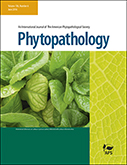 Biocontrol with antibiotic-producing Pseudomonas spp. is well established but lacks consistency and broad-spectrum pathogen suppression. Bankhead et al. tested three recombinants of Pseudomonas spp., which were introduced into the soil, during successive growth cycles of barley, navy bean, and pea to determine the impact of crop species on rhizosphere colonization of each strain. The timing of the introduction and the hosts determined the rhizosphere competence of the recombinant strains. The authors caution that the risk posed by the genes introduced in the recombinants needs to be assessed before deploying them for biocontrol.
Biocontrol with antibiotic-producing Pseudomonas spp. is well established but lacks consistency and broad-spectrum pathogen suppression. Bankhead et al. tested three recombinants of Pseudomonas spp., which were introduced into the soil, during successive growth cycles of barley, navy bean, and pea to determine the impact of crop species on rhizosphere colonization of each strain. The timing of the introduction and the hosts determined the rhizosphere competence of the recombinant strains. The authors caution that the risk posed by the genes introduced in the recombinants needs to be assessed before deploying them for biocontrol.
Chinese translation by Dr. BoMing Wu, China Agricultural University, Beijing, China
使用产抗生素假单胞菌进行生物防治已经较为成熟,但是还欠缺稳定性和抑菌广谱性。Bankhead等在三种宿主植物上检测了产生两种抗生素的重组假单胞菌相对于只产生单一抗生素的亲本菌株的根围竞争力。研究发现施用时间和宿主植物决定重组菌株的根围竞争力。作者警示在把重组菌株用于生物防治之前应评估其导入基因所蕴含的风险。
Spanish translation by Dr. German Sandoya, University of California, Davis
El biocontrol con antibióticos que produce Pseudomonas spp. está muy bien establecido pero carece de consistencia y de un control amplio de patógenos. Bankhead et al. probaron recombinantes de Pseudomonas spp. que producen dos antibióticos en comparación con el patovar parental que produce uno solo para la competencia de rizosfera en tres hospedantes. El tiempo de introducción y el hospedante determinaron la competencia de la rizosfera de los patovares recombinantes. Los autores advierten que el riesgo que representa por la introducción de genes en los recombinantes necesita evaluarse antes de usarlos para biocontrol.
May 2016
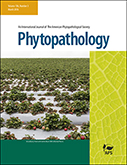 Toughing It Out—Disease-Resistant Potato Mutants Have Enhanced Tuber Skin Defenses
Toughing It Out—Disease-Resistant Potato Mutants Have Enhanced Tuber Skin Defenses
View Article
Thangavel et al. evaluated the mechanisms of enhanced tuber resistance in potato somaclones with resistance to Streptomyces spp. and the toxin thaxtomin A. Signaling genes associated with innate defense responses were not differentially expressed between the resistant and susceptible clones. However, the resistant clones reacted to both pathogen and toxin by producing additional cell layers in the tuber periderm and accumulating greater suberin polyphenols in these tissues.
Review Article: Ebb and Flow of Airborne Pathogens: Monitoring and Use in Disease Management Systems
View Article
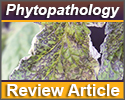 Mahafee and Stoll review historical attempts to associate plant diseases caused by airborne pathogens with wind patterns along with contemporary efforts to monitor and quantify such pathogens using state-of-the-art molecular techniques and then utilize this information to manage plant diseases. Improved accuracy in weather prediction and pathogen quantification are expected to result in robust disease prediction in real time. These exciting developments need to be tempered, however, by the still-developing scales for sampling of these pathogens.
Mahafee and Stoll review historical attempts to associate plant diseases caused by airborne pathogens with wind patterns along with contemporary efforts to monitor and quantify such pathogens using state-of-the-art molecular techniques and then utilize this information to manage plant diseases. Improved accuracy in weather prediction and pathogen quantification are expected to result in robust disease prediction in real time. These exciting developments need to be tempered, however, by the still-developing scales for sampling of these pathogens.
April 2016
 Role of Pest Control Advisers in Preventative Management of Grapevine Trunk Diseases
Role of Pest Control Advisers in Preventative Management of Grapevine Trunk Diseases
View Article
The proverb “An ounce of prevention is worth a pound of cure” could be as relevant to plant disease management as it is to human medicine, yet it is not always followed in some plant systems. In a unique and fascinating study, Hillis et al. compared preventative and postinfection recommendations of pest control advisors (PCAs) on multiple diseases in California vineyards. Despite the higher costs of postinfection measures, PCAs recommended them more often than preventative measures. Educating growers and PCAs about both types of measures may improve disease management while lowering costs.
Chinese translation by Dr. BoMing Wu, China Agricultural University, Beijing, China
古老的谚语 “一分预防胜过十分治疗”对于植物病害管理和人类医学来说一样有效,但是在一些植物病害系统中却很少被遵从应用。在一个独特而有趣的研究中,Hillis等比较了加利福尼亚州有害生物防治顾问们(PCAs)对葡萄园发生的多种病害提供的预防性和侵染后防治建议。虽然(侵染后措施相对于预防性措施来说)花费更高,但PCAs却更多地建议侵染后的控制措施。因此,加强教育,让生产者和PCAs同时了解这两类措施,不用花费太多就可以提高植物病害管理水平。
Spanish translation by Dr. German Sandoya, University of California, Davis
El proverbio antiguo que dice "más vale prevenir que lamentar" podría ser efectivo en el manejo de enfermedades en plantas así como lo es en medicina humana, aunque se practica en menor frecuencia en algunos sistemas vegetales. En un estudio único y fascinante, Hillis y colaboradores comparan recomendaciones preventivas y post infección de asesores de control de plagas (PCAs por sus siglas en ingles) en viñedos californianos para varias enfermedades. A pesar de los costos elevados, los asesores de control de plagas recomiendan prácticas post infección en mayor proporción que medidas preventivas. El entrenamiento de los productores y asesores en ambas medidas, por tanto, puede mejorar el manejo de enfermedades a bajos costos.
March 2016
Contrasting Interaction Patterns of Wheat Blast and Fusarium Head Blight on Wheat Genotypes
 View Article
View Article
Ha et al. examine the responses of wheat genotypes that differ in resistance to two ear pathogens: Magnaporthe wheat blast and Fusarium graminearum. While portions of ear tissues were colonized similarly by both pathogens, the biochemical and pathogenesis-related gene expressions were remarkably distinct. These results suggest differential resistance mechanisms in wheat cultivars against the two pathogens and the need to combine resistance against multiple wheat pathogens in cultivars.
Chinese Translation
Translated by Dr. Boming Wu, China Agricultural University
Ha(哈)等人研究了不同抗性基因型对Magnaporthe sp. 引起的麦瘟与和Fusarium graminearum 引起的赤霉病的反应。两种病原在部分小麦穗组织的定植相似的同时,致病相关基因的表达却大为不同。结果显示小麦品种对这两种病原的抗病机制不同,未来有必要在小麦品种中组合针对多种小麦病原的抗性基因。
Spanish Translation
Translated by Dr. German Sandoya, University of California, Davis
Ha et al, examinan la respuesta de genotipos de trigo que difieren en resistencia a dos hongos diferentes, el tizón del trigo cuyo agente causal es Magnaporthe sp., y el tizón de la espiga por Fusarium cuyo agente causal es Fusarium graminearum. Aunque parte del tejido de la espiga tuvo síntomas similares por los dos patógenos, la expresión genética bioquímica y de genes relacionados con la patogénesis fue notablemente distinta. Los resultados sugieren mecanismos de resistencia diferenciales en cultivares de trigo a estos patógenos y la necesidad de combinar resistencias a varios patógenos de trigo en un mismo cultivar.
February 2016
 Diversity of Xanthomonas campestris Isolates from Symptomatic Crucifers
Diversity of Xanthomonas campestris Isolates from Symptomatic Crucifers
View Article
Lange et al. used pathogenicity and DNA fingerprinting to reveal the presence of two X. campestris pathovars, raphani and campestris, in New York State; the latter was identified most frequently. In New York, black rot of crucifer is caused by a combination of locally surviving inoculum and a yearly infusion of novel isolates of these pathovars on infected transplants and seed.
January 2016
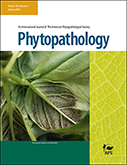 Field Evaluation of Plant Defense Inducers for Control of Citrus Huanglongbing
Field Evaluation of Plant Defense Inducers for Control of Citrus Huanglongbing
View Article
In a multiyear, multifield study, Li et al. evaluated chemicals that induce host resistance and identified three that singly or in combination suppressed huanglongbing and improved fruit yield and quality. This approach has the potential of extending the lives of affected trees.
Chinese Translation
Translated by Dr. Chang-Lin Xiao, USDA-ARS, Parlier, CA
因有限的防治措施,消毁被感染的树是柑橘黄龙病导致的最大的损失。在这一多年多点的研究里,Li 等评价了多种化学物质的诱导寄主抗病性并鉴定了三种化学物质既能单独或混合施用来抑制黄龙病并提高果实的产量和品质。这一方法有延长被感染树的寿命的潜能。
Spanish Translation
Translated by Dr. German Sandoya, University of California, Davis
Ante las opciones limitadas de control, la destrucción de árboles afectados es la consecuencia más dramática causada por Huanlonging o verdeo de los cítricos. En un estudio en diferentes años y localidades, Li et al evaluaron químicos que inducen la resistencia en el hospedante e identificaron tres árboles que individualmente o en combinación contuvieron Huanglongbing y mejoraron la calidad y rendimiento de lo frutos. Esta estrategia tiene el potencial de extender la vida de los arboles afectados.
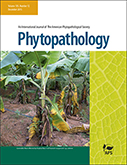 December 2015
December 2015
Comparison of Quantitative PCR Assays for Fusarium virguliforme from Soybean Roots and Soil
View ArticleIn a multilaboratory comparison of six qPCR assays for
Fusarium viguliforme, which causes sudden death syndrome in soybean, Kandel et al. found multicopy gene-based assays to be superior in pathogen detection and quantification. These assays were found to be more sensitive and slightly less specific relative to single gene-based assays.
November 2015
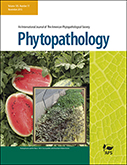 Population Subdivision of Fusarium graminearum from Barley and Wheat
Population Subdivision of Fusarium graminearum from Barley and Wheat
View Article
Correlation between the type of toxin produced (chemotype) and population structure in Fusarium graminearum, the causal agent of head blight, is well established in wheat but not in barley. Using robust population genetic analyses of strains of Fusarium graminearum from barley and wheat, Liang et al. found that subdivision within the barley population corresponded with that of previously described wheat populations.
Chinese
麦类赤霉病菌禾谷镰孢菌产生的毒素与病菌群体结构的相关性已知发生在小麦上, 但不知是否也发生在大麦上. 梁等作者对在可相比的时间和地区从大麦和小麦上采集的菌系进行群体遗传分析表明在大麦上病菌群体的分化和其毒素化学类型相关, 与小麦上的规律类似. 在这两种作物上, 病菌群体已同时从90年代前的主导毒素化学类型 (15ADON) 转变成目前的毒素化学类型 (3ADON).
Spanish
La correlación entre el tipo de toxina (quemotipo) y la estructura de la población en Fusarium graminearum, el agente causal del mildiu de la espiga, está bien definido en trigo pero no en cebada. Con el uso de un método robusto de genética poblacional en las razas de cebada y trigo que se colectaron al mismo tiempo y lugar, Liang et al. demuestran que la subdivisión de la población en cebada corresponde también con los quemotipos, similar a los del trigo. La población cambia de un quemotipo predominante (15ADON) desde antes de los años 90’s al actual quemotipo (3ADON) lo que parece haber ocurrido en ambos cultivos simultáneamente.
October 2015
Streptomycin Resistance in Isolates of Erwinia amylovora from California Pears
View Article
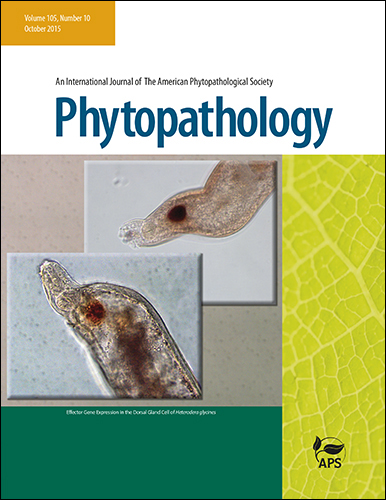 Förster et al. report of a genetic analysis of transposon-mediated low-level streptomycin resistance in strains of Erwinia amylovora from California pears between 2006 and 2014. The occurrence of streptomycin-resistant strains declined precipitously in 2013 and 2014. The authors suggested that the lack of persistence of this resistant genotype could be due to the instability of the transposon or the plasmid harboring it or because the low-level resistant strains were actually controlled by streptomycin present on plant surfaces at labeled rates. This calls for continued but judicious use of streptomycin in fireblight management.
Förster et al. report of a genetic analysis of transposon-mediated low-level streptomycin resistance in strains of Erwinia amylovora from California pears between 2006 and 2014. The occurrence of streptomycin-resistant strains declined precipitously in 2013 and 2014. The authors suggested that the lack of persistence of this resistant genotype could be due to the instability of the transposon or the plasmid harboring it or because the low-level resistant strains were actually controlled by streptomycin present on plant surfaces at labeled rates. This calls for continued but judicious use of streptomycin in fireblight management.
Chinese Translation
Förster等人报道了对2006至2014之间采自加利福尼亚梨树的火疫病菌株中一个转座子介导的低水平链霉素抗性进行的遗传分析。其发现链霉素耐药性菌株的发生率在2013和2014发生急剧下降。作者认为,这种耐药基因型缺乏持久性可能是由于该转座子或承载抗性的质粒不稳定, 或者由于低水平耐药菌株实际上被按注册用量施用于植物表面的链霉素所控制。这一结果显示在梨火疫病的防治中应该持续而谨慎地使用链霉素。
Spanish Translation
Förster y colaboradores informan de un análisis genético del transposón mediado para la resistencia a bajo nivel de razas de estreptomicina de Erwinia amylovara de las peras en California entre 2006 y 2014. La incidencia de las razas resistentes a estreptomicina bajó rápidamente en 2013 y 2014. Los autores sugieren que la falta de persistencia del genotipo resistente podría ser debido a la inestabilidad del transposón o del plásmido que lo contiene o porque las razas con nivel bajo de resistencia de hecho se controlaron por la estreptomicina presente en la superficie de las plantas a índices recomendados. Esto, hace un hincapié en el uso continuado, pero acertado, de estreptomicina en el manejo del fuego bacteriano.
September 2015
Inhibition of Phytophthora parasitica and P. capsici by Synthesized Silver Nanoparticles
 View Article
View Article
Nanotechnology has found applications in multiple fields. Attempts to utilize this technology for control of plant pathogens and other agricultural uses have only recently been initiated. Ali et al. synthesized silver nanoparticles (AgNPs) in an aqueous extract of the medicinal plant Artemisia absinthium and evaluated the effects on inhibiting Phytophthora spp. In addition to completely inhibiting several developmental stages of P. parasitica and P. capsici in vitro, AgNPs prevented disease on inoculated tobacco plants and without phytotoxicity.
Spanish Translation
En años recientes se han encontrado aplicaciones en varios campos para la nanotecnología y los materiales que apoyan este campo. Recientemente se ha intentado utilizar esta tecnología en el control de patógenos de plantas y en otros usos agrícolas. En la edición de Septiembre, Ali y colaboradores sintetizaron nano partículas de plata (AgNPs) en un extracto acuoso de la planta medicinal, Artemisia absynthium y evaluaron las AgNPs para la inhibición de Phytophthora spp. Además de la completa inhibición de varios estados del desarrollo de P. parasítica, and P. capsici in vitro, las AgNPs también previnieron la enfermedad en plantas de tabacos inoculadas sin fitotoxicidad.
Chinese Translation
近几年纳米技术及其材料已经应用多个领域. 近来也有试图将这一技术应用于防治植物病菌和其它农业领域. 在九月份期刊中, Ali及合作者从药用植物蒿的提取液中合成了一些银色纳米颗粒物并且研究了其对疫霉菌的抑制作用. 除了能完全抑制致病疫霉和辣椒疫霉在体外生长的多个生育阶段外, 这些银色纳米颗粒物还能防止在接种烟草上病害的发生而且不产生植物药害.
August 2015
Predicting Cereal Root Disease
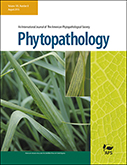 View Article
View Article
Root diseases are a major impediment to the production of cereal crops in western Australia, and determining preplant pathogen levels allows for better disease management. Poole and colleagues report on their extensive analysis of the relationship among preplant soil pathogen DNA levels, seasonal rainfall, and temperature. The predictive model they developed resulted in improved risk assessment for several root pathogens in wheat.
Spanish Translation
Las enfermedades de la raíz como la pudrición de la corona, Pudrición de la raíz por Rhizoctonia, Mal del pie y lesiones en la raíz por nematodos son la mayor causa en reducción de la producción de cereales en Australia, información en niveles del patógeno previo a siembra resulta en un mejor manejo de la enfermedad. En la edición de Agosto, Poole y colaboradores informan en su análisis extensivo de la relación entre los niveles en el suelo de ADN del patógeno previo a sembrar, precipitación de temporada y temperatura. El modelo desarrollado condujo a una mejor evaluación del riesgo para varios patógenos de la raíz.
Chinese Translation
根部病害, 像冠腐病,Rhizoctonia根腐,全蚀病及根腐线虫,是澳大利亚禾谷类作物生产的主要限制因素。了解作物种植前土壤中的病菌水平有助于更有效的病害管理。在Phytopathology的八月份这一期刊中,Pool 和其合作者报导了他们对作物种植前土壤中的病菌DNA水平和季节降雨量及温度关系的深入分析。他们建立的模型有助于提高对几种根部病菌的风险分析。
June 2015
New Insights into the Life Cycle of the Wheat Powdery Mildew Pathogen
 View Article
View Article
The pathogen that causes wheat powdery mildew, Blumeria graminis f. sp. tritici, has been studied extensively, but an important part of its life cycle—infections by ascospores—has not been explored in detail. In the June issue, Jankovics et al. report that B. graminis f. sp. tritici ascospores produce a single germ tube, unlike conidia and most other powdery mildew pathogens. The lack of variability among isolates of this pathogen suggests that ascospores and chasmothecia (=cleistothecia) likely play a role in its survival between crops, instead of serving as potential sources of genetic variability.
May 2015
Reducing Reproduction of the Root-Knot Nematode
View Article
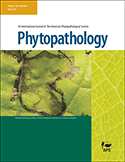 Meloidogyne incognita causes billions of dollars annually in crop losses worldwide. Integrated control tactics provide inconsistent results, and host resistance is available in only a few crops. In the May issue, Lourenço-Tessutti et al. report on using plant-mediated RNAi to generate transgenic tobacco expressing dsRNA specific to two M. incognita stress-tolerance and survival-related genes: heat-shock protein 90 (HSP90) and isocitrate lyase (ICL). Relative to wild-type tobacco plants, plants expressing the HSP90 silencing construct delayed gall formation and reduced egg numbers by approximately 50%, and plants that silenced ICL reduced oviposition by approximately 80%. Silencing these targets in different hosts offers a novel strategy for nematode control.
Meloidogyne incognita causes billions of dollars annually in crop losses worldwide. Integrated control tactics provide inconsistent results, and host resistance is available in only a few crops. In the May issue, Lourenço-Tessutti et al. report on using plant-mediated RNAi to generate transgenic tobacco expressing dsRNA specific to two M. incognita stress-tolerance and survival-related genes: heat-shock protein 90 (HSP90) and isocitrate lyase (ICL). Relative to wild-type tobacco plants, plants expressing the HSP90 silencing construct delayed gall formation and reduced egg numbers by approximately 50%, and plants that silenced ICL reduced oviposition by approximately 80%. Silencing these targets in different hosts offers a novel strategy for nematode control.
Spanish translation
Meloidogyne incognita causa anualmente miles de millones de dólares de pérdidas en diferentes cultivos alrededor del mundo. Las tácticas de control integrado proveen resultados inconsistentes y resistencia a este nematodo solo se encuentra en pocos cultivos. En la edición de Junio, Lourenco-Tessutti et al. presentan el empleo de ARNi en plantas para generar tabaco transgénico que expresa dsARN específico a dos genes de tolerancia a estrés y supervivencia en M. incognita, la proteína de choque térmico (HSP90) y la liasa isocitrato (ICL). Con respecto a las plantas de tabaco no transformadas, las que expresan el silenciamiento de HSP90 tuvieron un retraso en la formación de agallas y reducción en número de huevos en un ~50% y las que expresaron el silenciamiento de ICL redujeron la ovoposición en un ~80%. El silenciamiento de ambos genes in diferentes especies de plantas ofrece una nueva estrategia para el control de nematodos.
Chinese translation
大豆根结线虫病(Meloidogyne incognita)每年在世界范围造成价值几十亿美元的作物损失。综合防治的效果不稳定,而且只有一些作物中有抗性品种可以利用。在本期(六月)杂志中,Lourenco-Tessutti 等人报道利用植物介导RNAi获得转基因烟草,成功表达双链RNA,特异性针对M. incognita与耐逆境和存活相关的两个基因,热激蛋白HSP90和异柠檬酸水解酶ICL。与野生烟草植物相比,HSP90被沉默的植株延缓了瘿瘤的形成,虫卵的数量减少了50%;而ICL被沉默的植株产卵量减少了80%。在寄主作物中沉默这些靶标基因提供了一个新的线虫防治策略。
April 2015
Specificity of a Rust Resistance Suppressor on 7DL in the Spring Wheat Cultivar Canthatch
View Article
 Stem rust, caused by Puccinia graminis f. sp. tritici, is a disease of worldwide importance on tetraploid (durum) and hexaploid (bread) wheat cultivars. The disease is managed primarily with host resistance. However, in cultivars with certain genetic backgrounds—such as the hexaploid cultivar Canthatch—the presence of a suppressor gene neutralizes the resistance genes and renders plants susceptible to stem rust. In the April issue, Talajoor et al. report on testing whether the suppressor gene also suppresses leaf and stripe rust resistance genes in Canthatch and finding that the effects of the suppressor are specific and limited to stem rust.
Stem rust, caused by Puccinia graminis f. sp. tritici, is a disease of worldwide importance on tetraploid (durum) and hexaploid (bread) wheat cultivars. The disease is managed primarily with host resistance. However, in cultivars with certain genetic backgrounds—such as the hexaploid cultivar Canthatch—the presence of a suppressor gene neutralizes the resistance genes and renders plants susceptible to stem rust. In the April issue, Talajoor et al. report on testing whether the suppressor gene also suppresses leaf and stripe rust resistance genes in Canthatch and finding that the effects of the suppressor are specific and limited to stem rust.
March 2015
Resistance to Strobilurin Fungicides by the Wheat Blast Pathogen
 View Article
View Article
Wheat blast, caused by Magnaporthe oryzae, is a major disease in Brazil, and its control has relied mainly on strobilurins. Fungal resistance to strobilurins is associated with two mutations in the cyt b gene: The G143A mutation confers high levels of resistance, and the F129L mutation confers moderate levels. In the March issue, Castroagudín et al. document that in M. oryzae populations from Brazil, the frequency of G143A mutations increased from 35% in 2005 to 90% in 2012. The authors therefore urge reevaluating strobilurin use in managing wheat diseases.
Spanish translation
El tizón del trigo cuyo agente causal es Magnaporthe oryzae es una enfermedad de gran importancia en Brasil donde se controla extensamente con strobilurins. La resistencia de los hongos a strobilurins se asocia con dos mutaciones en el gen cyt b. La mutación G143A y la F129L confiere altos y moderados niveles de resistencia. En esta edición, los autores Castroagudín y Ceresini et al documentan que en las poblaciones de M. oryzae de Brasil la frecuencia de mutación de G143A incremento de 35% en 2005 a 90% en 2012. Por lo que los autores consideran que se debe revaluar el uso de strobilurin para el control de enfermedades en trigo.
Chinese translation
Magnaporthe oryzae引起的麦瘟病已成为巴西的一个主要病害,而甲氧基丙烯酸酯(strobilurin)类杀菌剂则被广泛用于其控制。真菌对该类杀菌剂的抗性与cyt b基因上的两个突变有关。其中G143A突变的抗性较高、F129L突变的抗性属于中等水平。在此期的Phytopathology中, Castroagudín和Ceresini等报道在巴西的M. oryzae群体中, G143A突变的频率从2005年的35%增加到了2012年的90%。因此,作者呼吁重新评估甲氧基丙烯酸酯类杀菌剂在小麦病害防治中的应用。
February 2015
Global Climate Change and Late Blight of Potato
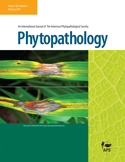 View Article
View Article
In the February issue, Shakya et al. compare the effects of fluctuating and constant temperatures on Phytophthora infestans, the pathogen of late blight of potato. Large deviations from <17°C reduced latent and incubation periods, but similar fluctuations at >17°C increased both parameters. In contrast, infection efficiency, lesion expansion, and sporulation all increased with small temperature fluctuations relative to constant temperatures but decreased with large fluctuations. The effects of variable conditions on plant diseases should therefore be considered in assessing the impact of climate change.
January 2015
Generation of a Cross-Protective Variant of Pepino mosaic virus
 View Article
View Article
Cross-protection has been successfully exploited to control a number of viruses; however, broader application of this technique has been prevented by difficulty in identifying milder strains of given pathogens. In the January issue, Chewachong et al. describe an elegant method of generating attenuated strains from a virulent strain of Pepino mosaic virus by substituting two amino acids in the capsid protein. One strain produced using this method offered protection against the virulent wild-type strain in both tomato and tobacco. This method of engineering plant viruses may offer a swift method of managing existing and emerging plant viruses.
George Sundin
Editor-in-Chief
2012—2014
December 2014
Detection of Downy Mildew Pathogens of Spinach
View Article
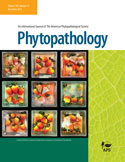 Downy mildew of spinach, caused by Peronospora effusa, is a destructive disease that can be controlled with properly timed fungicide applications. In the December issue, Klosterman et al. report using a species-specific, real-time quantitative PCR assay in conjunction with spore trapping to provide a rapid system for delivering the information growers need to make decisions about fungicide usage. The 18S rRNA gene revealed target sequences used in probe and primer development that distinguished P. effusa from related Peronospora spp. Further clarifying the relationship between spore counts and disease development will further increase the significance of this system.
Downy mildew of spinach, caused by Peronospora effusa, is a destructive disease that can be controlled with properly timed fungicide applications. In the December issue, Klosterman et al. report using a species-specific, real-time quantitative PCR assay in conjunction with spore trapping to provide a rapid system for delivering the information growers need to make decisions about fungicide usage. The 18S rRNA gene revealed target sequences used in probe and primer development that distinguished P. effusa from related Peronospora spp. Further clarifying the relationship between spore counts and disease development will further increase the significance of this system.
November 2014
Divergence of Acidovorax citrulli Strains
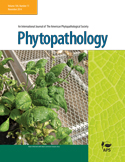 View Article
View Article
In the November issue, Eckshtain-Levi and colleagues analyze the distribution of 11 type III effector genes in 22 strains of Acidovorax citrulli, causal agent of bacterial blotch of cucurbits. The authors identify two main strain groups and support these results with virulence data on various cucurbit hosts and with DNA fingerprinting. The authors also identify a third group of low-virulence strains, for which a lack of three effector genes may contribute to lowered virulence. This research identifies a clear direction for future studies of host–pathogen interactions and host resistance of A. citrulli.
October 2014
Sudden Vegetation Dieback of Salt Marshes in New England
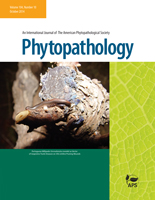 View Article
View Article
In the October issue, Elmer reports on the tripartite interaction among smooth cordgrass (Spartina alterniflora), the pathogen Fusarium palustre, and the purple marsh crab (Sesarma reticulatum). Crab herbivory increased on plants inoculated with the fungus and/or stressed by drought conditions. Elmer presents several hypotheses to explain the crab’s increased attraction to diseased and/or drought-stressed plants and notes that this tripartite interaction severely limits the recovery potential of coastal salt marshes from sudden vegetation dieback (SVD).
September 2014
 Mandarin Okitsu Leaves and Canker Disease Resistance
Mandarin Okitsu Leaves and Canker Disease Resistance
View Article
In the September issue, Favaro et al. assess resistance of mandarin cultivar Okitsu to Xanthomonas citri subsp. citri, causal agent of citrus canker. Resistance associated with leaf age was evident in spray-inoculated plants but not plants inoculated by infiltration, and bacterial populations declined on leaves over 2 weeks following inoculation. Also, biofilm formation appeared reduced on Okitsu leaves compared with leaves of susceptible cultivar Clemenules. The authors propose that physical characteristics of the Okitsu leaf surface are involved in resistance to X. citri.
August 2014
Yr36 and Resistance to Wheat Yellow Rust in Cool Climates
View Article
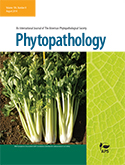 In the August issue of Phytopathology, Segovia et al. investigate Yr36—previously described as a high-temperature, adult-plant resistance gene—for its ability to confer partial resistance to wheat yellow rust at temperatures below 25°C. Under field conditions (average maximum daily temperatures of 16.9 and 18.8°C in two growing seasons) and under controlled environmental conditions (below 18°C), Yr36 conferred partial resistance to the fungus that causes yellow rust. This response was affected by plant developmental stage and broke down under high disease pressure. These findings suggest that Yr36 may be an effective source of partial resistance for wheat grown in regions with cool climates, such as northern Europe.
In the August issue of Phytopathology, Segovia et al. investigate Yr36—previously described as a high-temperature, adult-plant resistance gene—for its ability to confer partial resistance to wheat yellow rust at temperatures below 25°C. Under field conditions (average maximum daily temperatures of 16.9 and 18.8°C in two growing seasons) and under controlled environmental conditions (below 18°C), Yr36 conferred partial resistance to the fungus that causes yellow rust. This response was affected by plant developmental stage and broke down under high disease pressure. These findings suggest that Yr36 may be an effective source of partial resistance for wheat grown in regions with cool climates, such as northern Europe.
Spanish translation courtesy of Luisa Castiblanco, Michigan State University
En la edición de Agosto de Phytopathology, Segovia et al, investigan el gen Yr36 - anteriormente descrito como un gen de resistencia en en plantas adultas, a temperaturas altas- for su habilidad de conferir resistencia parcial a la roya amarilla del trigo a temperaturas inferiores a 25ºC. Bajo condiciones de campo (temperaturas promedio máximas diarias de 16.9 y 18.8ºC en dos temporadas de crecimento) y bajo condiciones ambientales controladas (por debajo de 18ºC), Yr36 confirió resistencia parcial al hongo que causa la roya amarilla. Esta respuesta se vio afectada por la etapa de desarrollo de la planta y se rompió bajo una presion alta de enfermedad. Estos hallazgos sugieren que Yr36 puede ser una fuente efectiva de resistencia parcial para trigo cultivado en regiones con climas fríos como el norte de Europa.
Chinese translation courtesy of Quan Zeng, Michigan State University
在八月期的植物病理学报上,Segovia等研究了之前被认为是高温,成株抗性基因的Yr36基因,在当气温低于25°C时对小麦条锈病的部分抗性。在田间试验条件下(两个生长季节平均每日最高气温分别为16.9°C和 18.8°C),以及可控环境条件下(温度低于18°C),Yr36使小麦能够部分抵抗导致条锈病的真菌。这种反应被植物发育阶段所影响,并且在高疾病压力下失效。这些结果表明,对于在像北欧等寒温气候下种植的小麦,Yr36可能是一个有效的部分抗性基因。
July 2014
Discrimination of Plant-Parasitic Nematodes from Complex Soil Communities
View Article
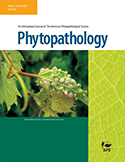 In the July issue of Phytopathology, Porazinska et al. examine the use of ecometagenetics—the simultaneous sequencing of all members of a complex community—as a tool for detecting plant-parasitic nematodes within soil communities. Substrates representing a gradient of complexity were examined, and some of the samples were spiked with concentrations of three known but contrasting species of nematodes. The authors reported correct and consistent detection in all cases for Pratylenchus spp.; however, a single cyst of Heterodera avenae was only detected about half the time it was present. The authors note that identifying and investigating sources of error in their studies will be critical for optimizing use of this method with plant pathogens.
In the July issue of Phytopathology, Porazinska et al. examine the use of ecometagenetics—the simultaneous sequencing of all members of a complex community—as a tool for detecting plant-parasitic nematodes within soil communities. Substrates representing a gradient of complexity were examined, and some of the samples were spiked with concentrations of three known but contrasting species of nematodes. The authors reported correct and consistent detection in all cases for Pratylenchus spp.; however, a single cyst of Heterodera avenae was only detected about half the time it was present. The authors note that identifying and investigating sources of error in their studies will be critical for optimizing use of this method with plant pathogens.
June 2014
Diversity of Ralstonia solanacearum in French Guiana
 View Article
View Article
In the June issue, Deberdt et al. present an analysis of strains of the bacterial wilt pathogen Ralstonia solanacearum from French Guiana. The authors determined that 26.3% of the 239 strains belong to phylotype IIB. Of these strains, 97% are of the emerging ecotype IIB/sequevar 4NPB—a group that is similar to the R. solanacearum clade that causes Moko disease of banana and is capable of causing disease on the bacterial wilt-resistant Hawaii 7996 tomato. The authors also observed that bacterial wilt can occur in crops during the first cycle after forest clearing, suggesting that the three phylotype groups recovered in French Guiana (I, IIA, IIB) may all be established in the natural environment. This finding contrasts with the earlier hypothesis that IIB/4NPB strains were introduced to French Guiana via ornamental and banana cuttings.
Spanish translation courtesy of Luisa Castiblanco, Michigan State University.
En la edición de junio, Deberdt et al. presentan un análisis de las cepas del patógeno del marchitamiento bacteriano, Ralstonia solanacearum, de la Guayana Francesa. Los autores determinaron que el 26.3% de 239 cepas pertenecen al filotipo IIB. De estas cepas, el 97% son del ecotipo emergente IIB/secuevar 4NPB, un grupo que es similar al clado de R. solanacearum causante de la enfermedad de Moko del banano y es capaz de causar enfermedad en la variedad de tomate Hawaii 7996, resistente a marchitamiento bacteriano. Los autores también observaron que el marchitamiento bacteriano puede ocurrir en los cultivos durante el primer ciclo después de la deforestación, sugiriendo que los tres filotipos recuperados en la Guayana Francesa (I, IIA, IIB) podrían estar establecidos en el ambiente natural. Este hallazgo contrasta con la hipótesis anterior de que las cepas IIB/4NPB fueron introducidas a la Guayana Francesa a través de esquejes de ornamentales y banano.
Chinese translation courtesy of Quan Zeng, Michigan State University.
在六月期上,Deberdt等对细菌性青枯病原菌--青枯雷尔氏菌在法属圭亚那的菌株进行了分析。作者发现在239株菌株中,26.3%的菌株属于种系型IIB。在这些菌株中,97%的菌株属于新兴生态型IIB/sequevar 4NPB。这个生态型群体与导致香蕉莫科病的青枯雷尔氏菌类似,并且可以在抗细菌性青枯病的夏威夷7996番茄上致病。作者同时观察到细菌性青枯病可以在森林砍伐后生长的第一批作物上致病,这说明在法属圭亚那提取的三个种系型(I, IIA, IIB)可能已经在自然环境中存在。这些发现与早期的IIB/4NPB菌株是通过观赏植物和香蕉的扦插插条引入到法属圭亚那的假说相反。
May 2014
Imaging of Nematode Development and Plant–Nematode Interactions
View Article
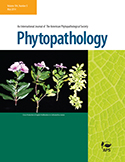 In the May issue of Phytopathology, Dinh et al. report a technological advance in nondestructive imaging of endoparasitic plant nematodes. The authors used the lipid analog PKH26—a lipophilic fluorescent dye—to label root-lesion, sugar beet cyst, and root-knot nematodes. Each nematode’s interactions with roots of Arabidopsis thaliana (grown in microscopy rhizosphere chambers) were studied using confocal microscopy for up to 27 days after inoculation, covering the parasite’s entire life cycle. The authors present stunning micrographs of each nematode pathosystem and propose that their new technique could significantly advance fundamental studies of plant–nematode interactions.
In the May issue of Phytopathology, Dinh et al. report a technological advance in nondestructive imaging of endoparasitic plant nematodes. The authors used the lipid analog PKH26—a lipophilic fluorescent dye—to label root-lesion, sugar beet cyst, and root-knot nematodes. Each nematode’s interactions with roots of Arabidopsis thaliana (grown in microscopy rhizosphere chambers) were studied using confocal microscopy for up to 27 days after inoculation, covering the parasite’s entire life cycle. The authors present stunning micrographs of each nematode pathosystem and propose that their new technique could significantly advance fundamental studies of plant–nematode interactions.
Spanish translation courtesy of Luisa Castiblanco, Michigan State University.
En la edición de mayo de Phytopathology, Dinh et al. reportan un avance tecnológico en la toma de imágenes no destructiva de nemátodos endoparasíticos de plantas. Los autores usaron el análogo lipídico PKH26 - un tinte fluorescente lipofílico- para marcar lesiones de raíz, quistes de remolacha azucarera y nemátodos del nudo de la raíz. Las interacciones de cada nemátodo con raices de Arabidopsis thaliana (crecidas en cámaras de microscopía rizosférica) fueron estudiadas usando microscopía confocal hasta 27 días después de la inoculación, cubriendo por completo el ciclo de vida del parásito. Los autores presentan micrografías sorpendentes de cada patosistema y proponen que su nueva técnica podría potenciar significativamente los estudios fundamentales de las interacciones planta - nemátodo.
Chinese translation courtesy of Quan Zeng, Michigan State University.
在五月期的植物病理学杂志上,Dinh等报道了一种对植物体内寄生线虫的无损成像的技术革新。作者使用亲脂性荧光染料PKH26(脂类似物)对根腐线虫,甜菜胞囊线虫,以及根结线虫进行了标记。在接种27天(包含了寄生虫整个生长周期)后,作者使用共聚焦显微镜对每种线虫与拟南芥(种植于显微镜根际培养皿内)的互作进行了研究。作者展示了令人惊叹的显微照片,描述了每个线虫的致病系统。并且,作者提议这种新技术可以显著推进植物-线虫互作的基础研究。
April 2014
Temporal Progression of ‘Candidatus Liberibacter asiaticus’ Infection in Citrus
View Article
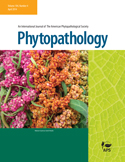 The Asian citrus psyllid is an important vector contributing to the rapid spread of huanglongbing (HLB) in citrus-growing areas worldwide. In the April issue of Phytopathology, Coletta-Filho et al. report that titers of the phloem-limited bacteria ‘Candidatus Liberibacter asiaticus’ rose rapidly and became saturated approximately 200 days after graft inoculation. The acquisition frequency of pathogen cells increased with time after inoculation and was highest when the pathogen cell titers were highest. However, acquisition also occurred within 60 days after inoculation, when cell titers were lower and plants were asymptomatic—a result that is problematic for management of HLB.
The Asian citrus psyllid is an important vector contributing to the rapid spread of huanglongbing (HLB) in citrus-growing areas worldwide. In the April issue of Phytopathology, Coletta-Filho et al. report that titers of the phloem-limited bacteria ‘Candidatus Liberibacter asiaticus’ rose rapidly and became saturated approximately 200 days after graft inoculation. The acquisition frequency of pathogen cells increased with time after inoculation and was highest when the pathogen cell titers were highest. However, acquisition also occurred within 60 days after inoculation, when cell titers were lower and plants were asymptomatic—a result that is problematic for management of HLB.
Spanish translation courtesy of Luisa Castiblanco, Michigan State University.
El psílido asiático de los cítricos es un vector importante que contribuye a la rápida propagación de la enfermedad de Huanglongbing (HLB) en las zonas productoras de cítricos en el mundo. En la presente edición de Phytopathogy, Coletta-Filho et al. reportan que los títulos del patógeno bacteriano limitado al floema 'Candidatus Liberibacter', se elevaron rápidamente y se saturaron en aproximadamente 200 días después de la inoculación por injerto. La frecuencia de adquisición de células del patógeno aumentó con el tiempo, después de la inoculación y fue más alta cuando los títulos de células del patógeno eran más altos. Sin embargo, la adquisición también ocurrió dentro de los 60 días después de la inoculación, cuando los títulos de células eran más bajos y las plantas no presentaban síntomas aún, un resultado que es problemático para el manejo de HLB.
Chinese translation courtesy of Quan Zeng, Michigan State University.
在世界各柑橘种植区域,亚洲柑橘木虱是黄龙病(HLB)快速传播的重要载体。在四月期的植物病理学报上,Coletta-Filho 等报道了专生于韧皮部细菌“Candidatus Liberibacter asiaticus”的滴度在嫁接接种后迅速增长,并于接种200天后达到饱和。病原菌细胞的采集频率在接种后随时间推移而增加,并且在当病原菌滴度最高时达到顶峰。然而,病原菌细胞在接种60天后仍可采集获得,而此时细胞效价已经较低并且植株已无症状。这项结果预示了黄龙病防治的新难题。
March 2014
Roles of a Solo LuxR in the Biological Control Agent Lysobacter enzymogenes
View Article
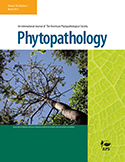 In the March issue of Phytopathology, Qian et al. show that LesR—a solo LuxR protein from the biocontrol agent Lysobacter enzymogenes—is involved in regulation of a heat-stable antifungal factor, acceleration of cell aggregation, and production of a melanin-like pigment. Solo LuxR proteins are quorum-sensing regulatory proteins that have developed the ability to sense exogenous N-acyl-homoserine lactone signals produced by neighboring bacteria. Qian et al.’s results suggest that chemical signaling between plant-associated bacteria can influence biological control activity in L. enzymogenes.
In the March issue of Phytopathology, Qian et al. show that LesR—a solo LuxR protein from the biocontrol agent Lysobacter enzymogenes—is involved in regulation of a heat-stable antifungal factor, acceleration of cell aggregation, and production of a melanin-like pigment. Solo LuxR proteins are quorum-sensing regulatory proteins that have developed the ability to sense exogenous N-acyl-homoserine lactone signals produced by neighboring bacteria. Qian et al.’s results suggest that chemical signaling between plant-associated bacteria can influence biological control activity in L. enzymogenes.
Spanish translation courtesy of Luisa Castiblanco, Michigan State University.
En la edición de marzo de Phytopathology, Qian et al. muestran que LesR -una proteína huérfana del tipo LuxR del agente biocontrolador Lysobacter enzymogenes- está involucrada en la regulación de un factor antifúngico termoestable, la acelaración de agregación celular y la producción de pigmentos tipo melanina. Las proteínas LuxR huérfanas son proteínas reguladoras de quorum sensing que han desarrollado la habilidad de percibir señales exógenas de N-acil homoserin lactonas producidas por bacterias vecinas. Los resultados de Qian et al. sugieren que la señalización química entre bacterias asociadas a plantas puede influenciar la actividad biocontroladora de L. enzymogenes.
Chinese translation courtesy of Quan Zeng, Michigan State University.
在三月期的植物病理学杂志上,Qian等发现生防菌Lysobacter enzymogenes 内的LuxR蛋白在热稳定抗真菌因子的产生,细胞聚集,黑色素类色素形成的上有调控作用。LuxR蛋白是群体感应调控蛋白,其作用是感应周围细菌所产生的外源N-酰基高丝氨酸内酯. Qian等的结果阐释了植物相关细菌间的化学信号传递可能影响L. enzymogenes的生防活性。
February 2014
Foliar Application of Biofilm Formation
 View Article
View Article
In the February issue of Phytopathology, Li and Wang report that the small molecules D-leucine and 3-indolylacetonitrile (IAN) inhibited biofilm formation by the citrus canker pathogen (Xanthomonas citri subsp. citri) on abiotic surfaces and host leaves. Treatment of cells with D-leucine or IAN also reduced copper resistance by the pathogen, and combinations of D-leucine and IAN with copper were more effective than copper alone in reducing disease on grapefruit leaves. These results illustrate the potential of small molecule biofilm inhibitors as a tool for managing citrus canker disease that may also reduce copper usage.
January 2014
Toxin Accumulation in Field Oat Grains
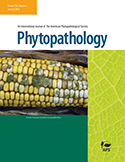 View Article
View Article
Fusarium head blight of wheat and barley has been widely studied, yet this disease on oat is less well understood. In the January issue of Phytopathology, Xu et al. report on their analysis of oat grain samples, collected from across the United Kingdom over a 3-year period, to detect mycotoxins. This information, along with weather data, was fed into statistical modeling experiments, which determined that the most important predictor of Fusarium head blight infection is the presence of wet conditions before anthesis, not during anthesis, as is the case for other head blight pathogens.
Phytopathology Editor's Pick translations courtesy of:
Dr. German Sandoya
University of Florida (Spanish)
Dr. BoMing Wu
China Agricultural University (Chinese)
Dr. Chang-Lin Xiao
USDA-ARS, Parlier, CA (Chinese)
